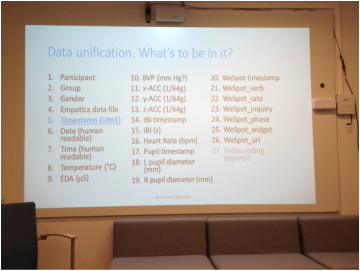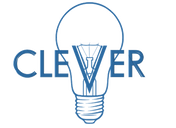
The SLAM project has begun and we are busy with our first pilot study. Our goal at this moment is to test the usability and functioning of a number of objective measures of affect and emotion to replace the usual subjective ones.
A well-known saying is: Why to do it the hard way if it is possible to do it easily? So the first question is WHY? There is so much research being done in the social sciences that makes use of subjective, self-report measures of how someone feels or experiences something, why then have we chosen not to do this too? Why do we find it so necessary to do it differently (other than that those who know me know that I pride myself in being different)?
Let’s say you want to measure how excited someone is with a birthday present. Of course you can ask her/him if (s)he was excited, but the chance is very large that (s)he will give you a ‘socially acceptable’ answer. And here is exactly the first problem with subjective self-report: People often give the answers they think the questioner wants to hear. But is it real?
We know that when people get excited about something, there are also physiological processes that mirror this. If someone gets excited, you’ll usually also see an increase in heart rate. Thus, if someone’s says that the present excites her/him but there was no increase in heart rate, then you might want to question the veracity of the answer. And if you can measure the heart rate, then you actually don’t even need to ask. Another example is if you become anxious (for example because the deadline is drawing near and the project you’re working on is not progressing well and thus, your grades will suffer). If this is the case, then you will probably begin to perspire, and the conductivity of your skin will increase. Thus, if you continually measure someone’s skin reactivity (i.e., their electrodermal activity) then you will be able to see if someone is becoming anxious and conclude that this is the case if the reactivity increases. This is the basis of a polygraph (lie detector).
And then you might want to know how excited (s)he is. Again you can ask, but along with the socially acceptable answer ‘extremely excited’ we come across a second problem, namely judging the degree of excitement. What does the respondent mean with ‘extremely’ and is the one ‘extremely’ the same as another? Thus, the second problem is the scale; how does the person benchmark her/his level of excitement? This, for example is one of the problems with an often used scale for measuring mental effort. When asked to report the degree of mental effort expended when solving a problem or carrying out a task, a learner doesn’t really have a benchmark to gage this. How much effort is a little or a lot and how do you compare it from one instance to another?
Going back to the earlier examples, if you have a base heart rate and a base galvanic skin response, and then continually or incidentally measure these two, you will not only be able to determine that someone is more excited or anxious, but also the degree of excitement and anxiety. And when you equate this with what (s)he is doing or saying at the moment, you can then see how a phenomenon that occurred during a collaborative session influenced one or more of the team members affective or emotional state of mind. Take for example your heart rate when exercising. By monitoring your heart rate during exercise, and equating it to the different exercises being done, you can determine how taxing each different exercise is.
In SLAM we want to measure a number of affective or emotional reactions that learners have when working with each other. We are studying the social regulation of collaborative learning, and as such, we need to get a good grip on the ‘social’ part of working in a group or team. How learners in a team work with and relate to each other is, to a certain extent, dependent on how they relate to and feel about each other. In order to interpret the processes observed during the learning experience, we need to know how the learners felt about each other and how they thought the others felt about them. I’m sure everyone reading this has worked with others in a team and had their behaviour modified by their feelings and emotions. Two of the project’s objectives are:
· Make visible situational characteristics (i.e., cognitive, motivational and emotional) that determine the success of individual, collaborative and collective learning.
· Find evidence for and representations of critical phases of students’ strategic regulation of learning (e.g., log traces, emotion tags, facial expressions).
The measures are:
· Heart interbeat interval, Heartbeats per Minute / Blood volume pulse
· Body temperature
· Hand/arm movement / Accelerometry
· Electrodermal activity
· Eye movements / Pupil reactions
· Recognition of facial expressions
· Recognition of vocal expressions
In the pilot we continually measured these objective markers along with what was happening in the teams. With the aid of data analytics, the next steps are to (1) see which measures change with which social and cognitive activities, and (2) see whether different markers yield similar results, allowing us to choose the simplest for our further research.
With a comprehensive dataset in our hands, we undertake this exciting, ambitious journey to understand and scaffold learners’ self-regulation when learning alone and socially-shared regulation when learning in groups. Keep an eye on the blog as we will be sharing insights and findings from the SLAM project as they appear.
-Paul Kirschner
A well-known saying is: Why to do it the hard way if it is possible to do it easily? So the first question is WHY? There is so much research being done in the social sciences that makes use of subjective, self-report measures of how someone feels or experiences something, why then have we chosen not to do this too? Why do we find it so necessary to do it differently (other than that those who know me know that I pride myself in being different)?
Let’s say you want to measure how excited someone is with a birthday present. Of course you can ask her/him if (s)he was excited, but the chance is very large that (s)he will give you a ‘socially acceptable’ answer. And here is exactly the first problem with subjective self-report: People often give the answers they think the questioner wants to hear. But is it real?
We know that when people get excited about something, there are also physiological processes that mirror this. If someone gets excited, you’ll usually also see an increase in heart rate. Thus, if someone’s says that the present excites her/him but there was no increase in heart rate, then you might want to question the veracity of the answer. And if you can measure the heart rate, then you actually don’t even need to ask. Another example is if you become anxious (for example because the deadline is drawing near and the project you’re working on is not progressing well and thus, your grades will suffer). If this is the case, then you will probably begin to perspire, and the conductivity of your skin will increase. Thus, if you continually measure someone’s skin reactivity (i.e., their electrodermal activity) then you will be able to see if someone is becoming anxious and conclude that this is the case if the reactivity increases. This is the basis of a polygraph (lie detector).
And then you might want to know how excited (s)he is. Again you can ask, but along with the socially acceptable answer ‘extremely excited’ we come across a second problem, namely judging the degree of excitement. What does the respondent mean with ‘extremely’ and is the one ‘extremely’ the same as another? Thus, the second problem is the scale; how does the person benchmark her/his level of excitement? This, for example is one of the problems with an often used scale for measuring mental effort. When asked to report the degree of mental effort expended when solving a problem or carrying out a task, a learner doesn’t really have a benchmark to gage this. How much effort is a little or a lot and how do you compare it from one instance to another?
Going back to the earlier examples, if you have a base heart rate and a base galvanic skin response, and then continually or incidentally measure these two, you will not only be able to determine that someone is more excited or anxious, but also the degree of excitement and anxiety. And when you equate this with what (s)he is doing or saying at the moment, you can then see how a phenomenon that occurred during a collaborative session influenced one or more of the team members affective or emotional state of mind. Take for example your heart rate when exercising. By monitoring your heart rate during exercise, and equating it to the different exercises being done, you can determine how taxing each different exercise is.
In SLAM we want to measure a number of affective or emotional reactions that learners have when working with each other. We are studying the social regulation of collaborative learning, and as such, we need to get a good grip on the ‘social’ part of working in a group or team. How learners in a team work with and relate to each other is, to a certain extent, dependent on how they relate to and feel about each other. In order to interpret the processes observed during the learning experience, we need to know how the learners felt about each other and how they thought the others felt about them. I’m sure everyone reading this has worked with others in a team and had their behaviour modified by their feelings and emotions. Two of the project’s objectives are:
· Make visible situational characteristics (i.e., cognitive, motivational and emotional) that determine the success of individual, collaborative and collective learning.
· Find evidence for and representations of critical phases of students’ strategic regulation of learning (e.g., log traces, emotion tags, facial expressions).
The measures are:
· Heart interbeat interval, Heartbeats per Minute / Blood volume pulse
· Body temperature
· Hand/arm movement / Accelerometry
· Electrodermal activity
· Eye movements / Pupil reactions
· Recognition of facial expressions
· Recognition of vocal expressions
In the pilot we continually measured these objective markers along with what was happening in the teams. With the aid of data analytics, the next steps are to (1) see which measures change with which social and cognitive activities, and (2) see whether different markers yield similar results, allowing us to choose the simplest for our further research.
With a comprehensive dataset in our hands, we undertake this exciting, ambitious journey to understand and scaffold learners’ self-regulation when learning alone and socially-shared regulation when learning in groups. Keep an eye on the blog as we will be sharing insights and findings from the SLAM project as they appear.
-Paul Kirschner

 RSS Feed
RSS Feed
